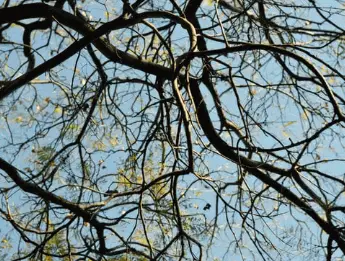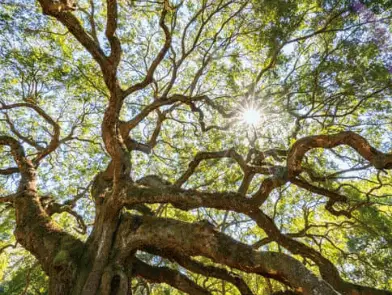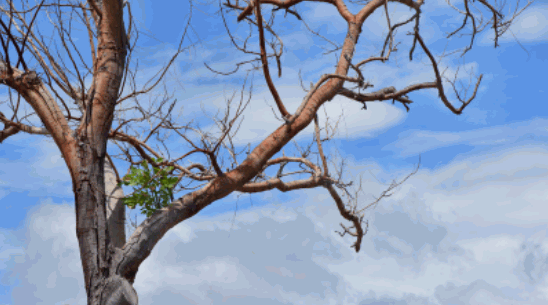Removing tree limbs and branches creates tree wounds, and just like with any other wound you come across, you might be tempted to treat it.
Wound dressings, pruning paint, tree pruning sealer and other petroleum-based and aloe vera/collagen tree wound dressing products are on hand to help. But are they necessary?
Typically, No.
In years gone by, landscape gardeners, professional arborists, and other tree professionals ALWAYS advised using some form of tree pruning sealer after pruning trees to treat tree wounds after removing tree branches and limbs. But recent scientific research conducted on the matter seems to suggest that pruning wounds after a tree limb or tree branch removal should be left to heal naturally.
But are there still some cases where you should seal cut tree limbs?
Why Tree Pruning Sealer Was Once So Popular
Pruning sealers or wound paint were once popular for a number of reasons. When you prune trees, you naturally cause some damage (although this can be reduced by following a strict pruning regime and using the right pruning tools). It’s natural, then, that in the past we tried our best to protect the living tree from the tree wound we were inflicting.
In the past, wound paint or a tree wound sealer was believed to have helped in a number of ways:
Bandage Tree Wounds
Previously, gardeners would seal a tree with pruning sealer to act as a bandage for the pruning cuts. They believed that by protecting the wound wood with a tree wound sealer; they were essentially bandaging an open wound and dressing it to protect it from other problems and speed up the recovery process.
Whilst this was common practice and a commonly held belief before the 70s, we now know natural healing for pruned branches is best – but more on this later.
Check out: How Do You Seal A Tree Wound

Prevent Decay
One benefit of a pruning sealer on a tree wound was believed to be preventing decay. By ‘Painting’ a thin layer of tree wound sealer or paint over the tree cut, was believed to help trees heal faster and prevent decay from happening.
In fact, the opposite may be true. When you seal a tree, you trap moisture in the tree wound, which can then cause further complications.
Check out: Best Tools To Cut Tree Branches
Prevent Disease
This belief is actually the one that holds most true, even today, but not in ALL circumstances.
Pruning cuts can be more susceptible to disease in certain circumstances, and by using a tree sealer on the sites of the tree pruning, the healing process can be sped up, preventing the risk of disease spread.
This is especially true if the reason you reached for the pruning shears, to begin with, was to remove diseased branches. By applying a wound sealer, you can prevent the disease from spreading further.
Prevent Sap Loss
This, again, still rings true today, but it isn’t always necessary. We’ll talk more about the exceptions below.
It is, however, true that wound sealer can minimize sap loss by helping trees recover from the initial shock of the fresh cut and makes holding on to their sap much easier. Tree sap is an essential part of a tree’s makeup, so it’s understandable why, in the past, gardeners would recommend saving as much sap as possible.
Nowadays, we understand more about sap loss as being a natural process trees go through after a tree wound. Pruning sealer isn’t always necessary.
Protect Trees Against Insect Infestations And Fungal Growth
Tree wound sealer and paint were also used to protect trees against fungi and insect infestations.
A sealer will act as a barrier against fungi and insects, that’s true. And it’s also true that pruning can spark fungal growth because the wood can dry out – so aloe gel can be helpful here.
Still, the new recommendation is to leave trees to their own devices when healing, but why?
Why Do Tree Branches No Longer Need Pruning Paint?
Recent research has largely shown that woody plants and trees can handle pruning themselves with natural healing. So long as pruning is carried out sensibly, such as with the compartmentalisation method.

Compartmentalisation Explained
Compartmentalisation is a method of pruning all trees – from fruit trees to oak trees, and everything in between.
Essentially, it means that you prune different areas of the tree to separate the damage. Rather than causing trauma to the same area of a tree and making the tree fight harder to heal those areas, compartmentalisation means you tackle different areas at different times, giving your tree time to heal itself before more pruning takes place.
By following this method, you can leave your tree to heal naturally without ever needing to apply wound dressings or sealer to protect it, because it’s more than capable of treating itself.
With compartmentalisation, trees are able to create their own wound wood with callus tissue that covers the wound and protects the tree naturally from disease, decay, fungi, and insects. A branch collar will develop naturally, protecting your trees.
Potential Problems CAUSED BY Using Pruning Sealer
There are also some problems that can be caused by using the different sealers that are on the market, such as:
- sealing in problematic moisture
- nourishing pathogens and disease
- preventing natural healing
So, allowing trees to take care of themselves is often your best bet.
When Pruning Sealer Can Help
In some circumstances, a sealer is necessary to help protect certain trees. You should research the tree you are pruning to find out what’s best, but a common example in the UK and the US is the oak tree.
Using just one thin layer of sealer to protect your oak tree after pruning is all that’s required, but it will promote leafy growth in the future and make healing a bit easier for the tree.
Protect Oak Trees From Oak Wilt
One reason oak trees require a sealer to help is because of oak wilt. Oak wilt is a common disease that can affect oak trees, and they are at their most vulnerable after cutting.

Protect Against Nitidulid Beetles
Oak wilt is a disease that spreads from tree to tree due to nitidulid beetles. Beetles are attracted to oak tree sap, and oak trees are known for their excessive sap after pruning. By sealing the oak tree wounds, beetles won’t be attracted to the tree, and the risk of disease reduces dramatically.
Tips For Pruning To Prevent Problems
Below are some tips to help with pruning that will reduce the risk of complications:
Prune Deciduous Trees
Deciduous trees are trees that require light, and annual pruning. These trees can handle pruning much better than other trees can, and they tend to heal much quicker after pruning, too.
That’s not to say other trees can’t be pruned – sometimes it’s important to do so, and you can check out our post ‘Why tree pruning is important‘ to find out more information. But if you can, try to avoid pruning non-deciduous trees unless strictly necessary.
Promote Air Circulation
When pruning, you should always aim to improve air circulation around the tree wounds because it helps with the compartmentalisation process, and also reduces the risk of rot and disease.
Make sure you cut away branches and limbs to improve circulation, discarding them properly instead of leaving them to land on lower branches.
Check out: How To Fix An Over-Pruned Tree
Promote New Growth
Prune your trees during late winter, right before new growth is expected. The expected growth will help heal the wounds quicker, speed up compartmentalisation, and protect the tree quicker.
If there is new growth, then there are no old wounds to cause issues down the line.
Check out: When Is The Best Time To Prune Trees In The UK
LEAVE TO HEAL NATURALLY
And the final tip we can give you is the most important tip of all: just leave your tree to heal on its own. It doesn’t need pruning paint or sealer, wound dressing or petroleum-based gels. It will heal just fine on its own.
Final Thoughts
Pruning your trees can be a stressful time, but so long as you prune them correctly, using the compartmentalisation method, and don’t put too much stress on your trees by pruning too much or too early in the year, then they ought to be just fine.
Trees are remarkable and can take care of themselves. After pruning, leave them to their own devices and they’ll surprise you with how quickly they heal on their own. In some rare cases, a sealer may be necessary to protect against disease or speed up recovery, but for the most part, your tree will heal quickly on its own without your help.

